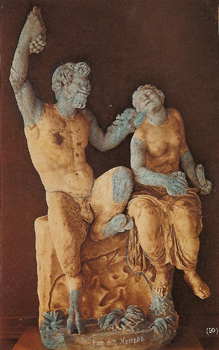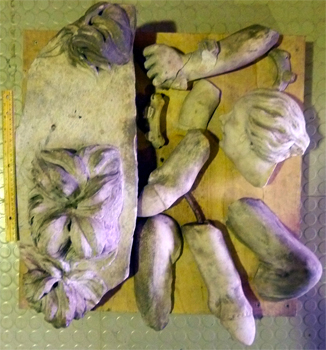The Digital Sculpture Project
Pan-Nymph Group

Pan-Nymph, ca. 1894 |

Pan-Nymph, 2008 |
At the invitation of the Dresden State Museums, The Digital Sculpture Project digitized a statue group known as "Pan-Nymph" in 2008. The group was purchased in 1728 in Rome and sent to Dresden where it was displayed in the museum. In the 19C, it was correctly observed that the statue group consisted of ancient and modern elements. The ancient fragments came from several unrelated statues that were integrated into a single sculpture in the baroque period by an unknown restorer, who added modern pieces, where needed, to fill out the composition. In 1894, the "Satyr-Nymph" was disassembled and the 23 ancient and modern fragments were removed from public view. The purpose of our project was to digitally restore the group to its 18C appearance by scanning each fragment, creating a 3D model of it, and then combining the 23 digital fragments so that the group could be seen again as it appeared prior to disassembly. Here can be found:
Collection: Staatliche Kunstsammlungen Dresden
Inventory Number: H4 61/34
Date Created: Created from ancient individual elements integrated and supplemented in the late 17c or early 18c.
Date Acquired: Purchased in Rome in 1728 from the collection of Fabrizio Naro.
Sculptor: unknown
Material & Dimensions: In 1894 the baroque additions in marble were removed and the group was decomposed into the following ancient elements:
In 2009, the group was reassembled using the ancient elements and the baroque supplements. In the process, three fragments which were originally considered baroque were discovered to be ancient, viz.:
Height of the whole group: 161 cm. Height up to Pan's head: 136 cm; width 93 cm; depth 66 cm. Size of plinth: 64 x 59 cm.
Description:
Goat-legged Pan sits on a cliff with his left leg crossed over his right and turns to a nymph sitting next to him, whom he playfully harasses. He tempts her with with a bunch of grapes in his upraised right hand and with his left hand he grabs her hair in order to pull her to himself. The nymph, with syrinx and tambourine in her hands and laughing saucily, escapes Pan's annoying behavior by attempting to turn away with a slight rotation of her upper body.
The group was forcibly pieced together in Rome (presumably in the early 18c) from a rich deposit of individual ancient elements. Missing pieces were made and added as needed when the recomposition was in progress. These additions include the head and neck of Pan and the nymph, the arms of the nymph and her knees, the right upper arm of Pan, his left knee and his lower legs as well as the base. For the latter an ancient relief was used. In this way a new ancient-baroque hybrid was created. That the result was of dubious value was something noted in the Dresden museum catalogues as early as the beginning of the 19c. In 1894 the group was disassembled, which proved that the work consisted of parts of wholly unrelated ancient statues, including two famous late-Hellenistic statue groups: the so-called "Invitation to the Dance" and the "Pan and Daphnis."
Granting that the disassembling of this curious construction was justified with regard to recuperation of the ancient originals, nevertheless in doing so we lost an attractive and interesting document of the baroque understanding of antiquity and its practice of restoration. Through a restoration recently started in 2009, the group could regain its baroque design.
A virtual model of the group makes it possible for the museum visitor to gain an overview of the ancient and baroque elements of the group and to understand how both the baroque and modern restorations were carried out. Moreover it is also possible for the visitor to grasp the relationship of the ancient fragments of the Roman copies to their Hellenistic models.
Selected Bibliography:
For the group, "Invitation to the Dance":
For the group, "Pan and Daphnis":
[Catalogue entry by Kordelia Knoll]
Copyright © 2009-10. Last updated: June 1, 2010.
The Digital Sculpture Project is an activity of the Virtual World Heritage Laboratory.Catalog Entry: Pan-Nymph Group
Name: Pan-Nymph Group

Click the image to view the 3D model (2,000,000 polygons). For help, click here.






















